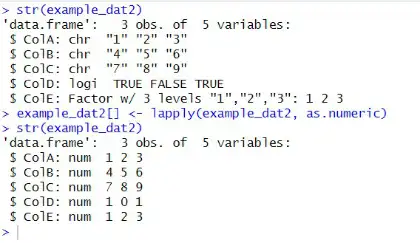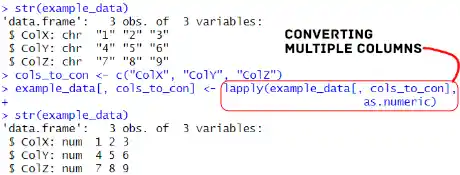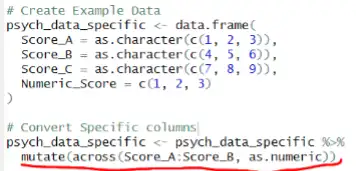In this post, you will learn how to convert multiple columns to numeric in R. Specifically, we will use the mutate family of functions within dplyr.
Real-world data scenarios, e.g., Psychology, may require column conversion. Consider instances where survey responses, initially stored as characters or sometimes null values, need transformation into a numeric format to be usable when carrying out data analysis. Such data manipulation tasks are therefore important for us and form the backbone of data preprocessing in psychological research.
Table of Contents
- Outline
- Prerequisites
- Base R: Converting Multiple Columns to Numeric
- dplyr Overview
- Convert Multiple Columns to Numeric in R with dplyr
- Convert Multiple Columns with Nulls to Numeric in R
- Comparing Base R and dplyr for Converting Numeric Columns
- Conclusion
- Resources
Outline
The structure of this post is as follows. Before learning how to convert multiple columns to numeric in R, we will have a brief look at the prerequisites to follow this post. Following that, we will explore the functions in Base R for converting data types. The post then takes a look at the dplyr package.
Prerequisites
Before converting multiple columns to numeric in R, you need a solid understanding of fundamental R concepts and data types. Familiarity with the structure of data frames and basic knowledge of R programming is also needed.
Additionally, ensure you have the dplyr (or tidyverse) package installed, as we will make use of some of its functions. To guarantee a seamless experience, check your R version and update R to the latest release if needed.
Base R: Converting Multiple Columns to Numeric
In Base R, several functions can convert multiple columns to numeric types. The apply() function, in combination with as.numeric(), allows for a versatile approach. Additionally, the lapply() function is handy when dealing with multiple columns simultaneously. Let us get into a few practical examples.
Consider a scenario where a Psychology dataset contains columns with numeric information stored as characters. To use in data analysis, we need to transform these columns into a numeric format.
Example 1: Base R to Change Multiple Columns to Numeric
Here is an example using as.numeric() and lapply() to convert multiple columns to numeric:
# Create a sample dataframe
example_data <- data.frame( Col1 = c("1", "2", "3"),
Col2 = c("4", "5", "6"),
Col3 = c("7", "8", "9") )
# Convert multiple columns to numeric using as.numeric()
example_data[] <- lapply(example_data, as.numeric)Code language: R (r)In the code chunk above, we used lapply() to convert all columns to numeric in R. We use [] so that the result is returned to the original dataframe.
However, note that this method may encounter issues with boolean or factor columns as it attempts to convert all columns to numeric. Look at the image below, for instance.

In the example, we will learn how to change the data type of specific columns using base R.
Example 2: Base R to Change Specific Columns to Numeric
Here is another example using as.numeric() and lapply() to convert multiple, but specific columns to numeric:
# Create a sample dataframe
example_data_specific <- data.frame(
ColX = c("1", "2", "3"),
ColY = c("4", "5", "6"),
ColZ = c("7", "8", "9")
)
# Convert specific columns to numeric using as.numeric()
example_data_specific[, c("ColX", "ColY", "ColZ")] <- lapply(example_data_specific[, c("ColX", "ColY", "ColZ")], as.numeric)Code language: PHP (php)In the code chunk above, we used lapply() to convert specific columns to numeric in R. Again, we used the [], but this time to select the specified columns, and lapply() applies the conversion function.

However, this approach can be cumbersome with many columns, leading us to explore a more dynamic method in the following example.
Example 3: Transform all Character Columns to Numeric in R
Here is an example using sapply() and lapply() to convert all character columns to numeric:
# Create a sample dataframe
example_data_all <- data.frame(
ColA = c("1", "2", "3"),
ColB = c("4", "5", "6"),
ColC = c("7", "8", "9"),
ColD = c(1, 2, 3),
ColE = factor(c("1", "2", "3"))
)
# Identify character columns
char_cols <- sapply(example_data_all, is.character)
# Convert all character columns to numeric using lapply()
example_data_all[char_cols] <- lapply(example_data_all[char_cols], as.numeric)Code language: PHP (php)In the code snippet above, we used sapply() to identify character columns in the dataframe. The result is a logical vector (char_cols) indicating which columns contain character data. Subsequently, we applied lapply() to convert only the identified character columns to numeric, avoiding unnecessary conversion of non-character columns. We can use this method more dynamically than manually selecting columns using []. In the next section, we will quickly look at the dplyr package and its use case.
dplyr Overview
In data manipulation in R, the dplyr package is a powerful tool. With its expressive syntax and easy-to-use functions, dplyr simplifies complex operations. When manipulating data, we can use the select() and mutate() family of functions to create clean and readable scripts. Importantly, the %>% operator (pipe) enhances the flow of operations, allowing for chaining of commands. As we learn to convert multiple columns to numeric, dplyr’s ease of use will become more evident. Functions like mutate_if() offer a solution to the challenges faced in base R (see above), allowing us to transform only the desired columns, such as character columns, easily and with fewer lines of code. The following section will look at examples of using dplyr to transform multiple columns to numeric in R.
Convert Multiple Columns to Numeric in R with dplyr
Key functions like mutate_all(), across(), mutate_if(), and select() offer precise control over column conversions. This section will show you how these functions can be used when converting multiple columns to numeric. In the first example, we will convert all columns to numeric using mutate_all.
Example 1: Converting All Columns to Numeric with dplyr
Using mutate_all(), we convert all columns to numeric. Here is an example:
# Create a sample dataset
cognitive_data <- data.frame(
Score1 = c("5", "4", "3"),
Score2 = c("2", "3", "4"),
Score3 = c("1", "2", "3")
)
# Convert all columns to numeric
cognitive_data <- cognitive_data %>%
mutate_all(as.numeric)Code language: PHP (php)In the code snippet above, we used dplyr’s mutate_all(), converting all columns to numeric. This function applies as.numeric to every column, similar to the approach with lapply() but more concise and readable, ensuring all scores are in numeric format. In the following example, we will use another function from the mutate-family: mutate_if.
Example 2: Selectively Conversion From Character to Numeric with mutate_if()
Using mutate_if() and is.character, we can selectively convert only the character columns, leaving others unchanged:
# Create a hearing science dataset
hearing_data <- data.frame(
Freq1 = c("440", "520", "630"),
Freq2 = c("75", "84", "91"),
Type = factor(c("pure_tone", "white_noise", "pure_tone"))
)
# Convert character columns to numeric
hearing_data <- hearing_data %>%
mutate_if(is.character, as.numeric)Code language: PHP (php)In the code snippet above, we used mutate_if(), to achieve a similar outcome to the base R example, where sapply() was used to identify and convert character columns. Here, we targeted columns identified by is.character and applied as.numeric to ensure a consistent numeric format for the hearing data. Again, this approach enhances readability and is easier to use compared to the base R method.
Example 3: Using across() for Selective Transformation of Columns to Numeric
The across() function allows for more targeted operations. We can specify the columns to be transformed. Here is an example:
# Create Example Data
psych_data_specific <- data.frame(
Score_A = as.character(c(1, 2, 3)),
Score_B = as.character(c(4, 5, 6)),
Score_C = as.character(c(7, 8, 9)),
Numeric_Score = c(1, 2, 3)
)
psych_data_specific <- psych_data_specific %>%
mutate(across(starts_with("Score"), as.numeric))Code language: PHP (php)In the provided code snippet, we used mutate(across()) to convert specific columns starting with “Score” to numeric format. Similar to our base R example where we selected columns explicitly, with dplyr’s across(), we can also achieve this by specifying the range using “Score1:Score3”.

Example 4: Convert Factors to Numeric in R
Again, using mutate_if, but this time together with is.factor we can transform factors to numeric in R:
# Example 3: Converting Factors to Numeric in R with dplyr
psych_data_factors <- data.frame(
Student_ID = 1:3,
Exam_1 = factor(c("A", "B", "C")),
Exam_2 = factor(c("B", "A", "C")),
Exam_3 = factor(c("C", "A", "B"))
)
psych_data_factors <- psych_data_factors %>%
mutate_if(is.factor, as.numeric)
Code language: PHP (php)In the code chunk above, we used the mutate_if() function to convert all factor columns to numeric. This approach is similar to our previous demonstration (i.e., Example 2), showcasing the efficiency of using dplyr functions for data manipulation tasks.
Convert Multiple Columns with Nulls to Numeric in R
Handling nulls, often represented as NA (Not Available) in R, is a crucial aspect of data preprocessing. Null values can arise due to missing data or undefined observations in a dataset. In this section, we will explore how to convert multiple columns with nulls to numeric using both base R and the dplyr package.
Example 1: Converting Multiple Columns with Nulls with Base R
Here is how we can convert multiple columns with nulls using Base R:
# Create a sample dataframe with nulls
null_data <- data.frame(
Col1 = c(1, 2, NA),
Col2 = c("3", NA, 5),
Col3 = c(6, 7, 8)
)
# Convert columns with nulls to numeric
null_data[] <- lapply(null_data, as.numeric)Code language: R (r)In this code snippet, we used lapply() to convert all columns with nulls to numeric in the base R environment. Note that this example is the same as in our previous example (i.e., earlier in the post) but with mixed values in the column (including NAs).
Example 3: Transforming Multiple Columns with NAs with dplyr
Again, we can use mutate_all if we want to convert all columns, including the ones with nulls, using dplyr:
# Create a sample dataframe with nulls
null_data_dplyr <- data.frame(
Col1 = c(1, 2, NA),
Col2 = c("3", NA, 5),
Col3 = c(6, 7, 8)
)
# Convert columns with nulls to numeric using dplyr
null_data_dplyr <- null_data_dplyr %>%
mutate_all(as.numeric)Code language: PHP (php)In the provided code chunk, we used the %>% pipe operator and the mutate_all() function to convert all columns, including those with nulls, to numeric data type. Note that this approach is consistent with the principles discussed in the earlier dplyr section. Again, this is an example of the concise syntax, ease of use, and flexibility of dplyr operations that efficiently streamline converting diverse columns.
Comparing Base R and dplyr for Converting Numeric Columns
When it comes to converting numeric columns in R, both base R and dplyr offer distinct advantages. Base R, part of the core R language, provides simplicity and independence from additional packages. This can benefit users seeking a lightweight solution without relying on external dependencies. On the other hand, dplyr excels in versatility and efficiency. It goes beyond column conversion, offering a powerful toolkit for various data manipulation tasks. With dplyr, tasks like renaming column names, renaming factors, and seamlessly adding columns to a dataframe become straightforward. While base R may be preferable for minimalistic tasks, dplyr is a comprehensive and efficient choice for users engaged in broader data preprocessing and manipulation activities.
Conclusion
In conclusion, this post has equipped you with the knowledge and skills to proficiently convert multiple columns to numeric in R using both base functions and the versatile dplyr package. The simplicity of base R provides a solid foundation for straightforward tasks, while dplyr’s efficiency, ease of use, and extensive functionality make it an excellent tool for broader data manipulation. As you work on your data analysis projects, consider the specific needs of your task to choose the most suitable approach. Remember, whether you opt for the simplicity of base R or the efficiency of dplyr, the goal is to streamline your workflow and enhance your data analysis capabilities.
If you have any questions, encounter challenges, or wish to share your experiences, please leave a comment below. Your engagement is valuable, and I aso encourage you to share the post on your social media accounts.
Resources
Here are some other data manipulation and dplyr posts:
- Not in R: Elevating Data Filtering & Selection Skills with dplyr
- How to Sum Rows in R: Master Summing Specific Rows with dplyr
- Countif function in R with Base and dplyr
- Sum Across Columns in R – dplyr & base
